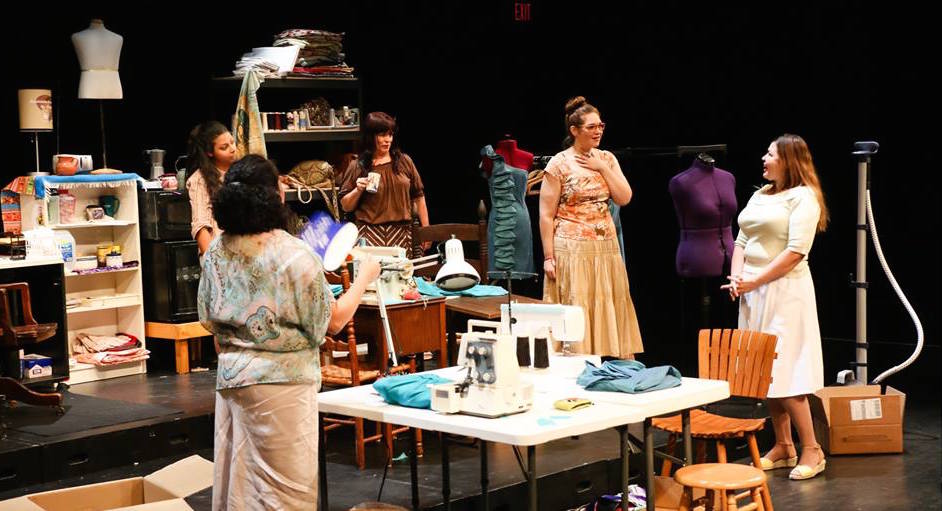Andrea Schermoly’s At High. photo by Sam English.
Serenade + At High + Velocity
Serenade
Choreography by George Balanchine
Music by Pytor Ilyich Tchaikovsky
At High
Choreography by Andrea Schermoly
Music by Gustav Mahler
Velocity
Choreography by Stanton Welch AM
Music by Michael Torke (Green and Ash)
A review by Keith Waits
Entire contents are copyright © 2019 by Keith Waits. All rights reserved.
The evening began with Balanchine. A stage of ballerinas in soft, pastel blue stand absolutely still with right hands extended high above their heads as the first notes of the score rise from the orchestra pit. Then those hands begin to turn together, a small gesture that encapsulates the essence of modern dance.
Robert Curran’s program notes indicate that Balanchine is exploring and cataloging technique here, and the piece is simultaneously abstract and romantic, it swoons while movement is executed on an academic foundation punctuated by moments of disruptive subversion. There are times that the bodies echo ritualistic forms.
Abstraction was also an essential aspect of Stanton Welch AM’s Velocity, strikingly designed for maximum chiaroscuro effect with female dancers in gleaming white and the males in sleek black, the movement set against a flat that looks like a Mondrian painting with all of the color leeched out. The movement was often intentionally mechanized, with arms pulled upward and knees pulled together to suggest marionettes or stiff-limbed repetition that put one in mind of a poseable figurine. The implication of speed in the title is most present in Michael Torke’s dynamic score, with the music nearly a virago, but the dance plays out a half-beat later in pace, still quite allegro but given just enough space for us to relish the expressiveness of each comic gesture and sweep of a leg.
Sandwiched between these two academic balances is the world premiere of Andrea Schermoly’s At High, a narrative about a young man’s experience in the afterlife. Serenade and Velocity were marvelous, but Schermoly’s piece felt fresh and innovative as if we were being introduced to a new vocabulary of dance, a stage filled with individual and at times unorthodox movements that forged context, story, and character through the choreography of the human form.
David Senti dances the central figure with a dawning awareness of his situation, panic becoming desperation before disorientation sets in. Mark Krieger and Leigh Ann Albrechta confidently occupy patriarchal and matriarchal archetypes with force and energy.
The music is from Mahler but the scenic design by Ezra Kellerman is a vivid minimalist approach to hierarchy and escape, featuring unusual linear lights that fraudulently beckon to the Youth with the promise of renewal. The costumes by Alexandra Ludwig are also simple, almost elemental, with evocative lighting design from Jesse Alford. All of the design work reinforces the tribalism at work in Schermoly’s choreography.
Not being a balletomane, I tend to respond more to this kind of work, in which the interplay of bodies exhibits an inexhaustible level of communication that might be termed expressionistic, and I suppose that is true of all dance, but At High for me captures the reason why we go to the ballet and the essential importance of Louisville Ballet’s commitment to its roster of young choreographers.
Serenade + At High + Velocity
October 18 & 19 @ 8:00 PM
October 19 @ 2:00 PM
Louisville Ballet
Kentucky Center for the Arts
501 West Main Street
Louisville, KY 40202
louisvilleballet.org
Keith Waits is a native of Louisville who works at Louisville Visual Art during the days, including being the host of LVA’s Artebella On The Radio on WXOX 97.1 FM / ARTxFM.com, but spends most of his evenings indulging his taste for theatre, music and visual arts. His work has appeared in LEO Weekly, Pure Uncut Candy, TheatreLouisville, and Louisville Mojo. He is now Managing Editor for Arts-Louisville.com.





